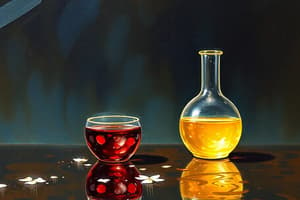Podcast
Questions and Answers
Which of the following statements accurately describes a system at dynamic chemical equilibrium?
Which of the following statements accurately describes a system at dynamic chemical equilibrium?
- The rate of the forward reaction is greater than the rate of the reverse reaction, favoring product formation.
- The rate of the forward reaction is equal to the rate of the reverse reaction, and the concentrations of reactants and products are constant. (correct)
- All reactions have ceased, and the concentrations of reactants and products are unchanging.
- The rate of the reverse reaction is greater than the rate of the forward reaction favoring reactant formation.
The equilibrium constant, K, changes when a catalyst is added to a reaction.
The equilibrium constant, K, changes when a catalyst is added to a reaction.
False (B)
For a reversible reaction: $N_2(g) + 3H_2(g) \rightleftharpoons 2NH_3(g)$, how will increasing the pressure affect the equilibrium?
For a reversible reaction: $N_2(g) + 3H_2(g) \rightleftharpoons 2NH_3(g)$, how will increasing the pressure affect the equilibrium?
The equilibrium will shift towards the product side (formation of $NH_3$).
If Q > K, the reaction will shift towards the ______ to reach equilibrium.
If Q > K, the reaction will shift towards the ______ to reach equilibrium.
Match each change to a system at equilibrium with its effect on the equilibrium position:
Match each change to a system at equilibrium with its effect on the equilibrium position:
Consider the reaction: $A(g) + B(g) \rightleftharpoons C(g)$. At a certain temperature, the equilibrium concentrations are [A] = 2 M, [B] = 3 M, and [C] = 4 M. What is the equilibrium constant, K_c, for this reaction?
Consider the reaction: $A(g) + B(g) \rightleftharpoons C(g)$. At a certain temperature, the equilibrium concentrations are [A] = 2 M, [B] = 3 M, and [C] = 4 M. What is the equilibrium constant, K_c, for this reaction?
For an exothermic reaction, decreasing the temperature will shift the equilibrium towards the reactants.
For an exothermic reaction, decreasing the temperature will shift the equilibrium towards the reactants.
Write the equilibrium constant expression for the following reaction: $2A(g) + B(s) \rightleftharpoons C(g) + 2D(g)$
Write the equilibrium constant expression for the following reaction: $2A(g) + B(s) \rightleftharpoons C(g) + 2D(g)$
According to Le Chatelier's Principle, adding heat to an endothermic reaction will shift the equilibrium towards the ______.
According to Le Chatelier's Principle, adding heat to an endothermic reaction will shift the equilibrium towards the ______.
The value of K for a reaction is 0.05. What does this indicate about the reaction at equilibrium?
The value of K for a reaction is 0.05. What does this indicate about the reaction at equilibrium?
Flashcards
Dynamic Chemical Equilibrium
Dynamic Chemical Equilibrium
State where forward and reverse reaction rates are equal, maintaining constant reactant and product concentrations.
Equilibrium Constant (K)
Equilibrium Constant (K)
Ratio of product to reactant concentrations at equilibrium, each raised to the power of its stoichiometric coefficient.
K_c
K_c
Equilibrium constant using molar concentrations.
K_p
K_p
Signup and view all the flashcards
Reaction Quotient (Q)
Reaction Quotient (Q)
Signup and view all the flashcards
Le Chatelier's Principle
Le Chatelier's Principle
Signup and view all the flashcards
Adding Reactants
Adding Reactants
Signup and view all the flashcards
Increasing Pressure
Increasing Pressure
Signup and view all the flashcards
Increasing Temperature
Increasing Temperature
Signup and view all the flashcards
Catalyst's effect
Catalyst's effect
Signup and view all the flashcards
Study Notes
- Dynamic chemical equilibrium is a state where the rate of the forward reaction equals the rate of the reverse reaction
- At equilibrium, the concentrations of reactants and products remain constant
Characteristics of Chemical Equilibrium
- Equilibrium is dynamic; forward and reverse reactions occur simultaneously
- Equilibrium is reached in a closed system; no matter can enter or leave
- Macroscopic properties are constant during equilibrium, such as concentration and pressure
- Equilibrium can be approached from either direction, using reactants or products
- Changing conditions like temperature, pressure, or concentration affects equilibrium
Equilibrium Constant (K)
- The equilibrium constant (K) is the ratio of product concentrations to reactant concentrations at equilibrium
- Each concentration is raised to the power of its stoichiometric coefficient
- For a reversible reaction aA + bB ⇌ cC + dD, the equilibrium constant expression is: K = ([C]^c[D]^d) / ([A]^a[B]^b)
Types of Equilibrium Constants
- K_c represents the equilibrium constant in terms of molar concentrations
- K_p indicates the equilibrium constant in terms of partial pressures (for gaseous reactions)
- K_p = K_c(RT)^Δn illustrates the relationship between K_c and K_p
- Δn represents the change in the number of moles of gas (products - reactants)
- R is the ideal gas constant
- T is the temperature in Kelvin
Magnitude of K
- K > 1 means products are favored at equilibrium
- K < 1 means reactants are favored at equilibrium
- K ≈ 1 indicates that neither reactants nor products are strongly favored
Reaction Quotient (Q)
- The reaction quotient (Q) measures the relative amounts of products and reactants present in a reaction at any given time
- Q uses the same expression as K, but with initial or non-equilibrium concentrations
- If Q < K, the ratio of products to reactants is less than at equilibrium, therefore, the forward reaction is favored
- If Q > K, the ratio of products to reactants is greater than at equilibrium, therefore, the reverse reaction is favored
- If Q = K, the reaction is at equilibrium
Le Chatelier's Principle
- Le Chatelier's Principle describes how a system at equilibrium responds to counteract changes and establish a new equilibrium
- Changes include adding heat, altering reactant or product concentrations, or modifying pressure
Effect of Concentration
- Adding reactants shifts the equilibrium towards the products
- Adding products shifts the equilibrium towards the reactants
- Removing reactants shifts the equilibrium towards the reactants
- Removing products shifts the equilibrium towards the products
Effect of Pressure/Volume
- Increasing pressure (decreasing volume) shifts the equilibrium towards the side with fewer moles of gas
- Decreasing pressure (increasing volume) shifts the equilibrium towards the side with more moles of gas
- Pressure changes have negligible effect if no change occurs in the number of moles of gas
Effect of Temperature
- Increasing temperature shifts the equilibrium in the direction of the endothermic reaction (ΔH > 0)
- Decreasing temperature shifts the equilibrium in the direction of the exothermic reaction (ΔH < 0)
- Temperature changes affect the value of the equilibrium constant, K
Effect of Inert Gases
- Adding an inert gas at constant volume does not affect the equilibrium position
- Adding an inert gas at constant pressure shifts the equilibrium towards the side with more moles of gas
Effect of a Catalyst
- A catalyst speeds up both the forward and reverse reactions equally, thus not affecting the equilibrium position
- A catalyst affects only the rate at which equilibrium is reached
Studying That Suits You
Use AI to generate personalized quizzes and flashcards to suit your learning preferences.




